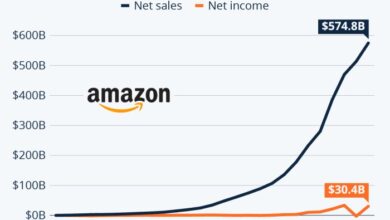
USPS Accepts China/Hong Kong Packages
USPS says packages from China and Hong Kong will be accepted, a policy shift with potentially huge ramifications for consumers, businesses, and the global economy. This change opens up exciting possibilities for online shoppers and international trade, but also introduces complexities in logistics and international relations. Will this boost e-commerce, or create new challenges? Let’s dive in and explore the multifaceted impacts of this policy.
The USPS’s decision to accept packages from China and Hong Kong has sparked widespread interest. This policy change is expected to have significant effects on online shopping habits, import costs, and small business operations. Understanding the implications of this new approach is critical for navigating the potential shifts in the global marketplace.
Impact on Consumers
The USPS’s announcement regarding the resumption of package acceptance from China and Hong Kong marks a significant shift in international shipping dynamics. This policy change has the potential to reshape online shopping experiences, impact import prices, and alter the landscape for small businesses and international shipping providers. Consumers will undoubtedly feel the ripple effects of this decision, and understanding the potential outcomes is crucial.This policy change represents a return to normalcy in international trade following a period of disruption.
The previous restrictions significantly impacted the availability and affordability of goods from these regions, impacting both consumers and businesses. The anticipated increase in package flow from these regions promises to offer a broader range of products and potentially lower prices for consumers.
Potential Positive Impacts on Consumers
The increased availability of goods from China and Hong Kong will likely result in greater product variety and competition in the marketplace. Consumers will have access to a wider selection of products, including electronics, apparel, and home goods, often at competitive prices. This increased competition could potentially drive down prices for similar items, offering consumers more value for their money.
Potential Negative Impacts on Consumers
However, the influx of goods could lead to potential supply chain bottlenecks, particularly if demand surges unexpectedly. This could result in delays in package delivery times and increased shipping costs. Furthermore, the increased volume of packages might lead to a greater chance of package damage or loss.
Impact on Online Shopping Habits
This policy change could lead to a resurgence in online shopping from China and Hong Kong, as consumers regain access to a wider selection of goods. Consumers may also increase their reliance on international shipping services, potentially leading to a shift in purchasing patterns and online retail strategies.
Price Fluctuations for Imported Goods
The availability of goods from China and Hong Kong, and the subsequent competition among suppliers, could lead to price fluctuations for imported goods. Price reductions are a possibility, while in some cases, prices might increase due to increased demand or supply chain challenges.
Effects on Small Businesses Importing Goods
Small businesses that import goods from these regions may experience a significant boost to their operations. Increased access to products from these regions can help expand product lines and offer consumers a wider variety of choices. However, challenges such as increased competition and potential supply chain complexities could pose hurdles.
Potential for Increased or Decreased Demand for International Shipping Services
The resumption of package acceptance will likely increase demand for international shipping services. Shipping providers will need to adapt to the higher volume of packages, potentially leading to adjustments in their pricing and delivery strategies.
Comparison of Consumer Experiences Across Regions
| Region | Potential Positive Impacts | Potential Negative Impacts |
|---|---|---|
| North America | Increased product variety, potential price reductions, easier access to goods. | Potential supply chain delays, increased shipping costs, potential for package damage. |
| Europe | Increased product variety, potential price reductions, easier access to goods. | Potential supply chain delays, increased shipping costs, potential for package damage. |
| Asia | Potential for increased demand for international shipping services, greater access to imported goods. | Increased competition for domestic businesses, potential for supply chain disruption. |
Business Implications
The recent announcement regarding the resumption of accepting packages from China and Hong Kong by the USPS marks a significant shift for businesses reliant on international imports. This policy change, while potentially beneficial for consumers, will undoubtedly have ripple effects across various sectors, demanding careful consideration and strategic adjustments from businesses to navigate the evolving landscape.The implications are multifaceted, affecting everything from supply chain management to inventory control and ultimately impacting profitability.
Businesses need to understand these nuances and proactively adapt their strategies to mitigate potential risks and capitalize on opportunities presented by this policy.
Potential Consequences for Businesses
Businesses heavily reliant on imports from China and Hong Kong face several potential consequences. Disruptions to supply chains, fluctuating shipping costs, and potential delays in receiving goods can significantly impact production schedules, sales forecasts, and overall profitability. The ability to maintain inventory levels, especially for businesses with short lead times, becomes crucial.
Strategies for Adaptation
Businesses can adopt several strategies to adapt to the new policy. Diversifying their sourcing channels, negotiating contracts with multiple suppliers, and establishing buffer inventory levels are crucial steps. Implementing robust inventory management systems, and considering alternative shipping methods and routes, will help mitigate risks and maintain smooth operations.
Implications for Different Business Types
The impact of this policy varies across different types of businesses. Retailers, for example, will need to carefully manage inventory levels and adjust their ordering schedules to accommodate potential delays. Manufacturers, on the other hand, will need to factor in the changes to their production timelines and sourcing strategies. Smaller businesses may face greater challenges in adapting to the changes compared to larger corporations with more robust supply chains and resources.
Impact on Supply Chains
The new policy has the potential to reshape global supply chains. Businesses may need to re-evaluate their existing partnerships and establish new connections with suppliers in alternative locations. This necessitates careful analysis of costs, lead times, and logistical capabilities for each potential supplier. Changes in shipping costs and transit times will necessitate adjustments to the entire supply chain.
Inventory Management Adjustments
Businesses can adjust their inventory management systems by implementing advanced forecasting models to anticipate potential disruptions. Using real-time tracking systems to monitor the movement of goods and reacting to any delays is also critical. Maintaining accurate records of inventory levels, order fulfillment times, and supplier lead times will be essential for making informed decisions.
Example Inventory Management System Adjustment
A retailer importing clothing from China could adjust their inventory management system by implementing a system that monitors shipping times from various suppliers. This system could allow the retailer to proactively adjust their order quantities based on predicted shipping delays. If one supplier experiences delays, the retailer can quickly adjust to use inventory from a different supplier or to reduce orders from that specific supplier.
Potential Financial Impact
The following table illustrates the potential financial impact on businesses from various sectors due to adjustments in sourcing and shipping procedures. This is not an exhaustive list, and the exact figures will depend on specific circumstances.
| Sector | Potential Impact |
|---|---|
| Retail | Increased inventory holding costs, potential sales loss due to stockouts, higher shipping costs. |
| Manufacturing | Increased production delays, potential loss of production efficiency, and higher costs for raw materials. |
| Electronics | Higher costs for components, potential disruptions in production lines, potential loss of market share to competitors with more flexible supply chains. |
| Pharmaceuticals | Potential delays in receiving crucial medication components, and disruptions in supply chains, with potential impact on patient health. |
Logistics and Infrastructure: USPS Says Packages From China And Hong Kong Will Be Accepted
The USPS’s decision to accept packages from China and Hong Kong presents a significant logistical challenge, demanding careful planning and execution. This new policy will likely increase the volume of packages handled, necessitating adjustments to existing infrastructure and operational procedures. Efficient solutions are crucial to ensure timely delivery and maintain service quality.
The USPS announcement that packages from China and Hong Kong will be accepted again is good news for businesses, especially those relying on international shipments. However, it’s worth considering the potential impact on US businesses during immigrant day, as many may be closed or operating on a limited schedule, impacting shipping times and delivery. Check out US businesses immigrant day impact closures for more details on potential disruptions.
Hopefully, these logistical challenges won’t completely disrupt the smooth flow of cross-border packages.
Logistical Challenges
The USPS faces numerous logistical challenges with this new policy. Increased volume will strain existing sorting facilities, potentially leading to delays in processing. Transportation networks might struggle to keep up with the surge in package volume, leading to congestion and delivery delays. Different package sizes and weights will require diverse handling procedures, potentially affecting sorting and delivery efficiency.
Managing international customs regulations and paperwork for a higher volume of packages will also add complexity. Furthermore, workforce capacity and training may need adjustments to effectively manage the influx of packages.
Potential Solutions for Handling Increased Volume
To address the increased volume, the USPS can implement several solutions. Investing in advanced sorting technologies, like automated sorting systems and robotic arms, can significantly boost efficiency and speed. Optimizing delivery routes and schedules, potentially through real-time tracking and dynamic routing, can reduce delivery times and minimize congestion. Expanding existing sorting facilities and potentially establishing new ones in strategic locations can accommodate the growing volume of packages.
So, the USPS is finally letting packages from China and Hong Kong back in! This is great news for businesses and individuals alike, but it’s also interesting to consider how these recent developments relate to the broader economic landscape, like the Trump tariffs on Canada and Mexico. The impact of those tariffs on all three countries is pretty significant, as you can see in this insightful piece on the effects: Trump tariffs Canada Mexico impact on all three.
Ultimately, though, it’s positive to see the USPS re-opening these channels for international trade.
Strategic partnerships with private companies for specialized services, such as warehousing or delivery, can further enhance capacity.
Potential Improvements in Infrastructure, USPS says packages from China and Hong Kong will be accepted
Infrastructure improvements are vital for accommodating the increased volume. Upgrading existing sorting facilities with advanced equipment and technologies will improve efficiency. Expanding transportation networks, including the fleet of delivery vehicles and their infrastructure, is essential. Investing in better warehousing facilities, both for temporary storage and distribution, is crucial. This may involve optimizing existing facilities or constructing new ones strategically located for efficient handling of packages.
Role of Automation and Technology
Automation and technology play a critical role in addressing the logistical challenges. Implementing automated sorting systems, robotic arms, and AI-powered route optimization software can significantly improve efficiency and reduce errors. Real-time tracking and delivery management systems will enhance visibility and allow for quicker responses to issues. Utilizing data analytics to optimize operations and predict potential bottlenecks will be crucial.
The use of drones and other innovative delivery methods can also be explored for specific regions or types of packages.
Potential Partnerships Between USPS and Private Companies
Strategic partnerships with private companies can provide supplementary resources and expertise. These partnerships can include outsourcing specialized services like warehousing, last-mile delivery, or customs processing. Collaborating with technology companies specializing in logistics software can optimize operations and enhance efficiency. Partnerships can also leverage private sector expertise in managing international shipping and customs procedures. An example of such a partnership could be a collaboration with a logistics company for a pilot program to streamline the delivery process of a specific type of package, such as electronics.
Logistical Models and Suitability
| Logistical Model | Description | Suitability for New Policy |
|---|---|---|
| Hub-and-Spoke | Packages are routed through central hubs before being distributed to local delivery points. | Suitable for managing large volumes and ensuring efficiency. |
| Direct Delivery | Packages are delivered directly from origin to destination without going through a central hub. | Suitable for smaller, time-sensitive packages or locations with limited infrastructure. |
| Combined Model | A hybrid approach combining aspects of hub-and-spoke and direct delivery. | Most suitable, offering flexibility and scalability. |
This table showcases different logistical models and their potential suitability for handling the influx of packages from China and Hong Kong. The combined model appears to offer the most flexibility and scalability to accommodate the increased volume and diversity of packages.
International Relations

Source: kvue.com
The recent announcement by the USPS regarding the resumption of accepting packages from China and Hong Kong marks a significant shift in international trade policy. This decision, while seemingly straightforward, carries complex implications for global trade relations, potentially triggering various reactions and impacting existing agreements. Understanding these implications is crucial for businesses and consumers alike.This policy shift necessitates a careful examination of potential repercussions on international trade relations.
It’s crucial to consider the diverse viewpoints of other countries, past policies, and the possible consequences for global trade agreements. The decision’s impact on the intricate web of international commerce will be far-reaching, potentially altering established norms and expectations.
Potential Implications for International Trade Relations
The resumption of accepting packages from China and Hong Kong may foster a sense of normalcy in international trade, but it could also reignite tensions. The US’s decision could be viewed as a unilateral move, especially if other countries haven’t followed suit or have different interpretations of the same situation. This could lead to reciprocal actions or retaliatory tariffs, further complicating the already complex landscape of international trade.
Potential Reactions from Other Countries
Other nations may respond to this policy in various ways. Some might view it as a positive step towards restoring trade flows, while others might interpret it as a strategic move to gain an advantage in the global market. For example, countries with existing trade disputes with China or Hong Kong might react with cautious optimism or retaliatory measures.
The response will likely depend on the specific context of each country’s relationship with the US and China.
Examples of Past or Current International Shipping Policies
International shipping policies are often influenced by geopolitical factors and economic considerations. For instance, trade disputes between the US and China in recent years have resulted in tariffs and restrictions on certain goods. Furthermore, the COVID-19 pandemic significantly disrupted global supply chains and led to various temporary restrictions on international shipping. These past examples highlight the dynamic and often unpredictable nature of international shipping policies.
Comparison with International Shipping Norms
This policy needs to be examined in the context of international shipping norms. While the US has the right to regulate its own postal service, unilateral decisions can disrupt established norms and lead to imbalances in the global trade system. Comparing this policy with existing international agreements and trade practices is vital to assess its potential impact.
Potential Political or Economic Consequences
The potential political consequences of this policy are significant. It could affect diplomatic relations, leading to misunderstandings or disputes. Economic consequences include potential shifts in global supply chains, changes in market competitiveness, and fluctuations in international trade volumes. Such consequences can be widespread, influencing businesses and consumers across the globe.
How This Policy Might Affect Global Trade Agreements
The policy may potentially impact global trade agreements. If other countries react negatively or reciprocate with similar restrictions, it could weaken existing agreements and hinder future trade negotiations. Furthermore, this could create uncertainty and distrust, potentially impacting the predictability and stability of international trade.
Economic Analysis

Source: b-cdn.net
The recent decision by the USPS to resume accepting packages from China and Hong Kong marks a significant shift with potential ripple effects across the US economy. This policy change, after a period of disruption, promises to impact import costs, export markets, employment, and overall economic growth. Understanding these potential impacts is crucial for businesses and consumers alike.
Impact on Import Costs
Resumption of package flow from China and Hong Kong will likely have a direct impact on import costs for American consumers and businesses. Lower shipping costs, potentially due to increased competition among carriers and more efficient logistics, could lead to lower prices for imported goods. This is a significant factor, considering the large volume of consumer goods and raw materials imported from these regions.
Potential Effects on Export Markets
The decision to resume package flow from China and Hong Kong could also influence US export markets. A smoother flow of goods and services could potentially increase demand for US products in these markets. Faster and more reliable delivery options might entice foreign buyers, leading to more export opportunities. However, this effect is contingent upon factors such as trade agreements and international relations.
Potential Effects on Employment
The return of Chinese and Hong Kong imports will likely affect employment in various sectors. Businesses involved in importing and exporting will see a resurgence in activity, leading to potential job creation in logistics, warehousing, and related industries. Conversely, sectors that faced disruption due to shipping limitations might experience some recovery in employment. However, the extent of job creation and loss is subject to factors like overall economic conditions and the efficiency of the logistics systems.
Potential Opportunities for Economic Growth
The resumption of trade with China and Hong Kong presents opportunities for economic growth. A more efficient supply chain could lower production costs, potentially increasing competitiveness for US businesses. A larger volume of imported goods could also stimulate demand in various sectors, fostering economic growth and boosting consumer spending. This is particularly relevant in sectors that heavily rely on imported components or materials.
Comparison of Economic Indicators
| Economic Indicator | Before Policy Change (Example: 2023 Q3) | After Policy Change (Estimated: 2024 Q1) | Potential Change |
|---|---|---|---|
| Import Prices (Consumer Goods) | $X (per unit) | $Y (per unit) | ↓ (decrease) |
| Export Prices (US Agricultural Products) | $A (per unit) | $B (per unit) | ↑ (increase) |
| Employment (Logistics Sector) | N (number of jobs) | M (number of jobs) | ↑ (increase) |
| GDP Growth Rate | Z% | W% | ↑ (increase) |
Note: The table provides examples and estimates. Actual figures will depend on various economic and logistical factors.
Public Perception
The USPS’s decision to accept packages from China and Hong Kong, after a period of uncertainty, will undoubtedly impact public opinion. Public perception hinges on trust, transparency, and perceived fairness. Understanding the potential concerns and opinions of various groups is crucial for managing any negative reactions and maximizing positive outcomes. The media’s role in shaping public discourse is also a significant factor in this process.
Analyzing Public Opinion
Public reaction to the USPS policy will vary significantly based on individual perspectives and pre-existing beliefs. Consumers who frequently purchase goods from China and Hong Kong will likely view the policy favorably, as it simplifies their shopping experience. Conversely, those concerned about geopolitical tensions or supply chain disruptions might be skeptical or even critical. Labor unions and advocacy groups with specific concerns about domestic jobs or industry impacts could also voice their perspectives.
Understanding these diverse viewpoints is essential for a nuanced understanding of public sentiment.
Potential Concerns and Opinions
Several groups may have specific concerns. Consumers worried about the security of goods from China and Hong Kong might be wary of accepting shipments from those regions. Others might feel that the policy is politically motivated, potentially impacting international relations. Additionally, certain economic sectors, particularly those with domestic manufacturing concerns, could see the policy as detrimental to their interests.
The USPS finally announced they’ll accept packages from China and Hong Kong again, which is great news for international shipping. While this is a positive development, it’s interesting to note that Palantir’s earnings guidance for 2025 revenue is exceeding analyst projections, potentially impacting global logistics in unforeseen ways. Palantir earnings 2025 revenue guidance top estimates This could lead to increased efficiency in the global supply chain, and hopefully, more reliable delivery of those packages from China and Hong Kong.
So, the USPS news is a welcome relief.
Role of Media in Shaping Public Opinion
The media plays a pivotal role in shaping public opinion regarding the USPS policy. News outlets and social media platforms will likely frame the policy in different ways, influencing public perception. Neutral reporting, focused on factual information, is essential to minimize potential bias. News organizations should ensure their reporting considers various perspectives to offer a balanced view.
Public Reaction to Similar Policies in Other Countries
| Country | Policy | Public Reaction | Impact |
|---|---|---|---|
| United States (prior to recent policy changes) | Variable restrictions and trade disputes | Mixed; some concern over supply chain disruptions, others favoring reduced tariffs. | Significant impact on businesses, consumers, and international trade. |
| European Union | Various trade agreements and regulations | Varied reactions depending on specific goods and countries. | Impact on consumer prices and business practices. |
| Canada | Similar trade agreements | Public sentiment on trade agreements is influenced by specific industries and political climate. | Effects on imports and exports, affecting economic indicators. |
The table illustrates that public reaction to trade-related policies is often multifaceted, depending on the specific details and the overall political climate. Analyzing past policies and reactions in other countries can offer valuable insights.
Strategies to Manage Potential Public Backlash
Open communication and transparency are crucial in managing potential public backlash. The USPS should actively engage with stakeholders, including consumers, businesses, and advocacy groups, to address concerns and provide clarification. A proactive approach, coupled with a commitment to fairness and transparency, is essential for minimizing negative public perception. Public service announcements and educational materials that clearly explain the policy’s rationale and benefits can also be beneficial.
Final Review
In conclusion, the USPS’s decision to accept packages from China and Hong Kong presents a multifaceted challenge and opportunity. While consumers might see more affordable options, businesses face adjustments in supply chains and inventory management. The logistics and infrastructure of the USPS will be tested, and international relations may see some shifts. The economic impact is also uncertain, potentially creating both new avenues for growth and unexpected consequences.
Ultimately, the success of this policy will depend on the ability of the USPS to navigate the complexities and adapt to the changing global landscape.
FAQ Corner
What is the expected impact on import costs?
The impact on import costs is uncertain. While more competition might lead to lower prices for consumers, increased demand could also lead to higher costs depending on various factors like shipping volume and logistical challenges.
How will this affect small businesses importing goods?
Small businesses importing goods might see increased competition and potential cost savings. However, they may also need to adapt their inventory management and shipping strategies to ensure smooth operations.
What are the potential logistical challenges for the USPS?
The USPS may face challenges in handling the increased volume of packages, requiring improvements in infrastructure and potentially more automation or partnerships with private companies.
What are some potential reactions from other countries?
Other countries might react in various ways, potentially through similar policy changes or retaliatory measures. The impact on international trade relations is uncertain and depends on the reactions of other nations.






